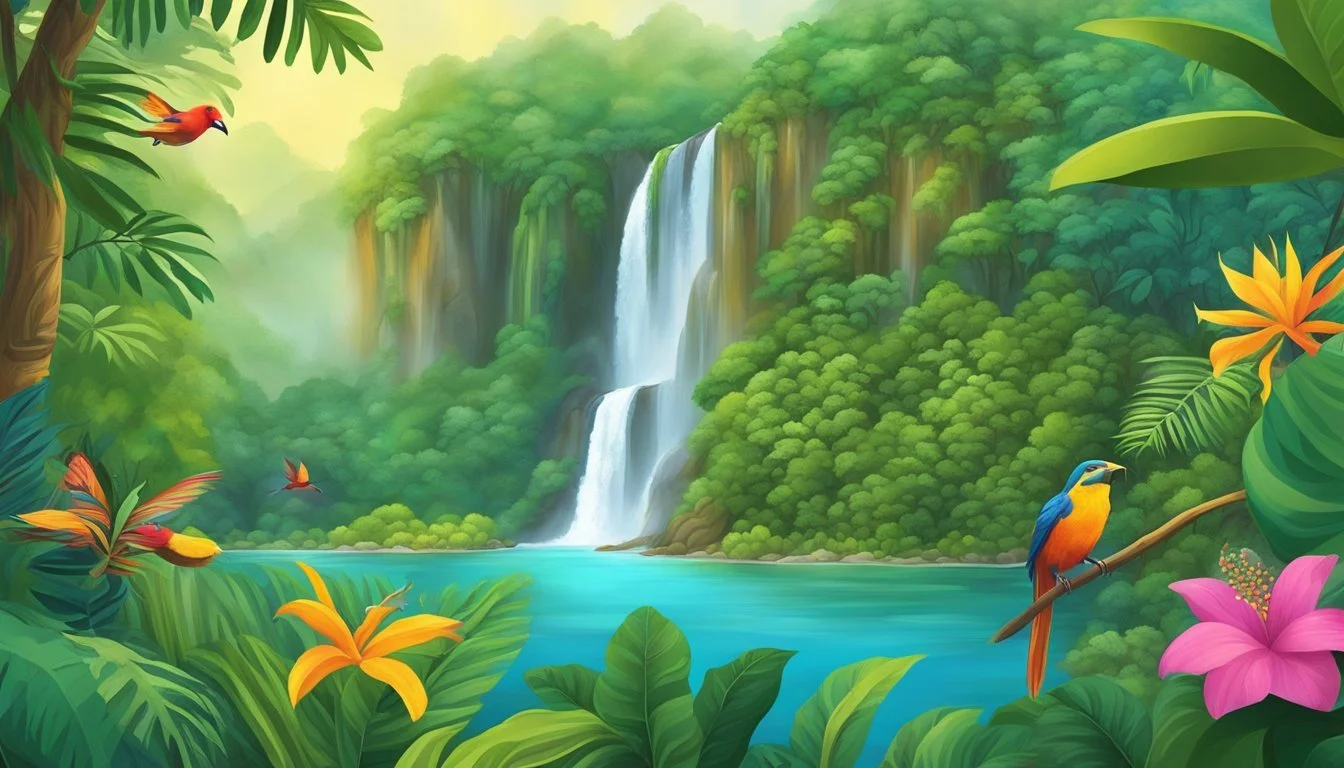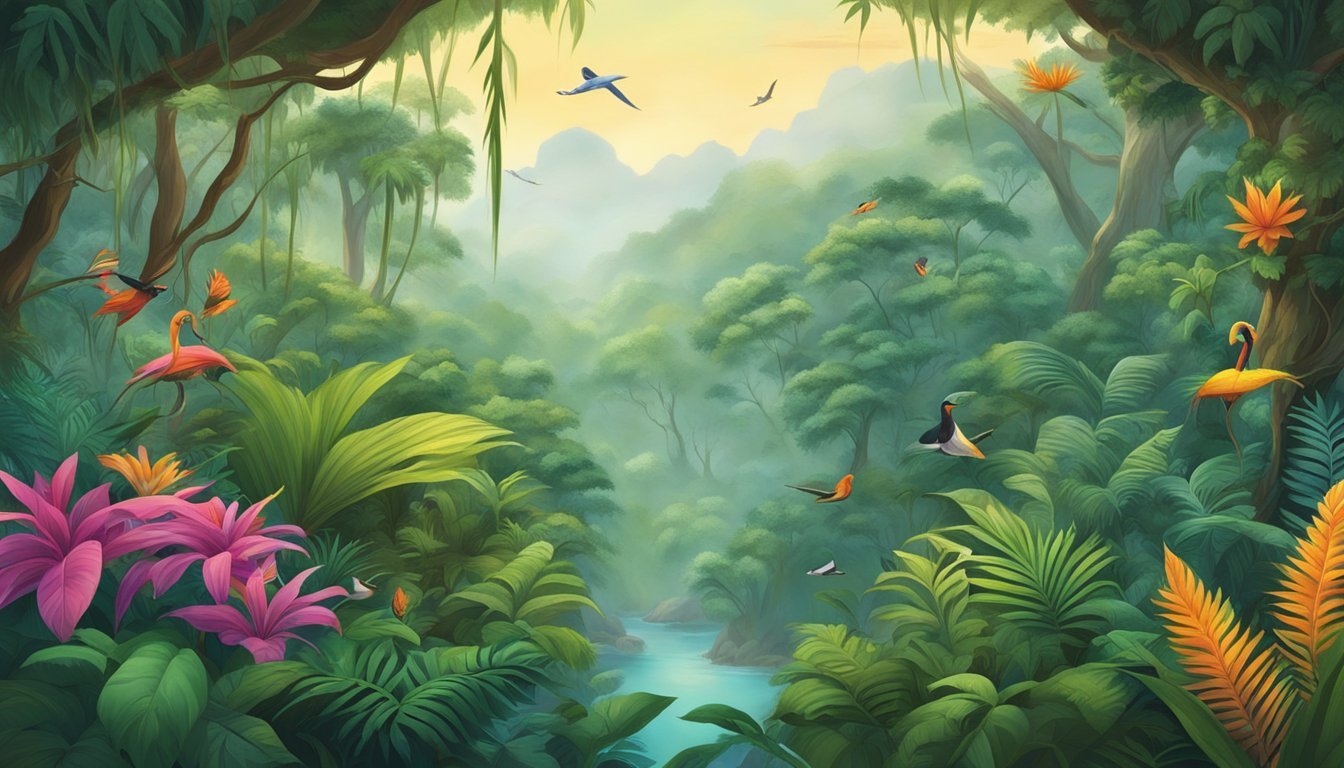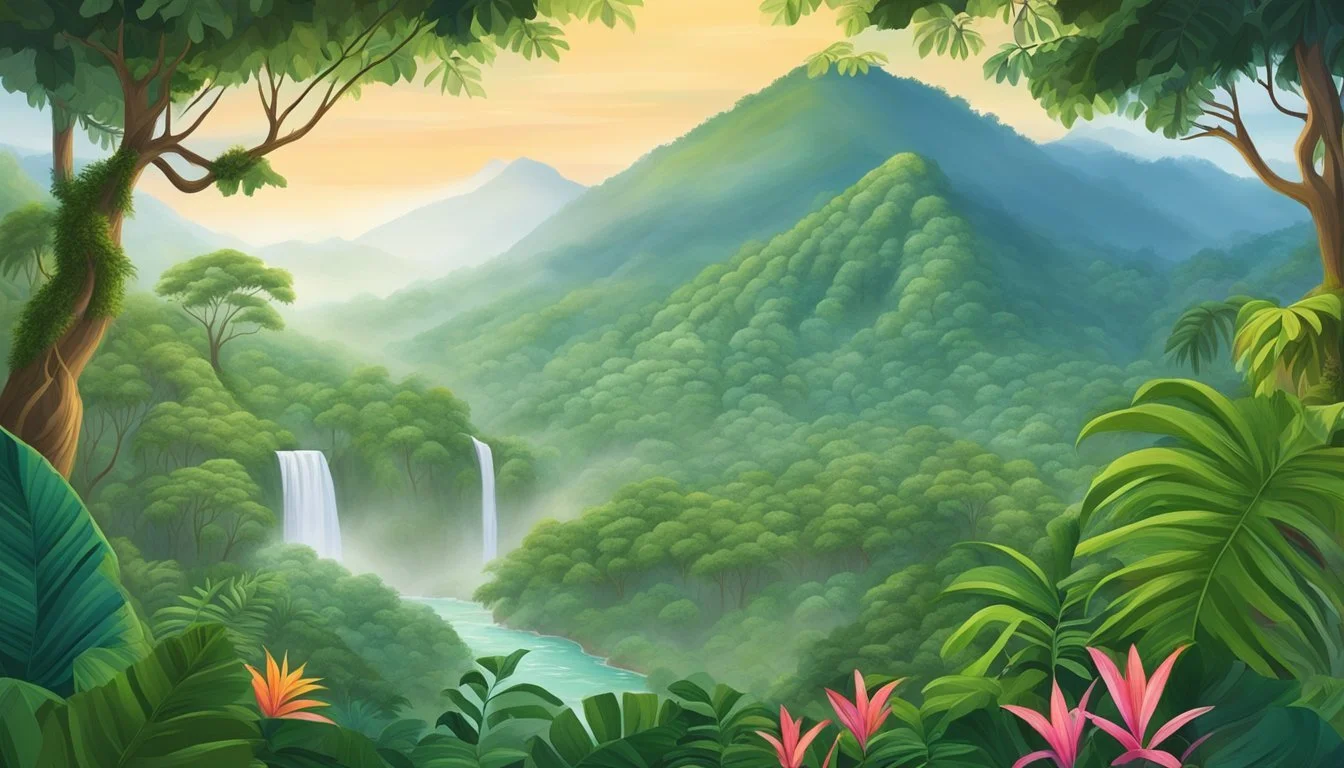10 Revealing Documentaries About Costa Rica
Unveiling the Hidden Gems of Central America
Costa Rica, a Central American paradise known for its lush landscapes and diverse wildlife, has captured the imagination of filmmakers and audiences alike. Documentaries about this small nation offer a window into its rich culture, unique ecosystems, and progressive policies.
These films provide viewers with insights into Costa Rica's commitment to environmental conservation, its abolition of the military, and its pursuit of sustainable development. From ancient creatures to modern social experiments, Costa Rica's story unfolds through the lens of talented documentarians, inviting viewers to explore this fascinating country from the comfort of their homes.
1) Our Bodies Are Our Lands
"Our Bodies Are Our Lands" is a thought-provoking documentary that explores the intricate connection between Costa Rican people and their natural environment. The film delves into the indigenous communities' perspective on land rights and environmental preservation.
Director Maria Suarez captures intimate moments with local activists and community leaders. They share their experiences and beliefs about the deep relationship between human bodies and the earth they inhabit.
The documentary highlights the struggles faced by indigenous groups in protecting their ancestral lands from external threats. It showcases their efforts to maintain traditional practices and sustainable ways of living.
Viewers are taken on a visual journey through Costa Rica's lush landscapes and diverse ecosystems. The film emphasizes the importance of biodiversity and its impact on human well-being.
"Our Bodies Are Our Lands" also examines the role of women in environmental conservation efforts. It portrays their leadership in grassroots movements and their fight for land rights.
The documentary serves as a powerful reminder of the interconnectedness of all living things. It challenges viewers to reconsider their relationship with nature and the consequences of human actions on the environment.
2) Costa Rica: A Little Green Story
"Costa Rica: A Little Green Story" is a captivating documentary that explores the country's renowned commitment to environmental conservation. The film showcases Costa Rica's impressive biodiversity and its efforts to protect it.
Viewers are taken on a journey through lush rainforests, pristine beaches, and volcanic landscapes. The documentary highlights Costa Rica's ambitious goal of becoming carbon neutral and its success in reversing deforestation.
The film also examines the challenges faced by Costa Rica as it balances economic development with environmental preservation. It features interviews with local conservationists, policymakers, and community leaders who share their perspectives on sustainable practices.
"Costa Rica: A Little Green Story" offers a nuanced look at the country's eco-friendly initiatives, including its extensive national park system and renewable energy projects. The documentary provides valuable insights into Costa Rica's role as a global leader in environmental stewardship.
Through stunning visuals and informative narratives, this film presents an engaging portrait of Costa Rica's natural wonders and its ongoing efforts to maintain its status as a green paradise.
3) Pura Vida, No Artificial Ingredients
"Pura Vida, No Artificial Ingredients" offers viewers an authentic glimpse into Costa Rica's laid-back lifestyle and natural beauty. This documentary showcases the country's commitment to preserving its environment and promoting sustainable living.
The film explores Costa Rica's diverse ecosystems, from lush rainforests to pristine beaches. It highlights the nation's efforts to protect its abundant wildlife and maintain its status as a global biodiversity hotspot.
Viewers are introduced to local communities embracing the "pura vida" philosophy. This concept, which translates to "pure life," embodies Costa Rica's approach to finding joy in simple pleasures and living in harmony with nature.
The documentary also examines Costa Rica's eco-tourism initiatives. It demonstrates how the country balances environmental conservation with economic development, creating unique experiences for travelers while safeguarding natural resources.
Through stunning visuals and insightful interviews, "Pura Vida, No Artificial Ingredients" captures the essence of Costa Rica's commitment to authenticity and sustainability. It invites viewers to appreciate the country's natural wonders and consider adopting elements of the pura vida lifestyle.
4) Jungle Symphony
"Jungle Symphony" offers a captivating auditory journey through Costa Rica's lush rainforests. This documentary showcases the diverse sounds of the country's wildlife, from the haunting calls of howler monkeys to the melodious chirps of exotic birds.
The film explores how different species communicate and interact within their environment. It highlights the importance of sound in the jungle ecosystem, revealing how animals use vocalizations for mating, territory marking, and warning signals.
Viewers are treated to close-up footage of various creatures producing their unique sounds. The documentary also examines how human activities impact the natural soundscape of Costa Rica's forests.
"Jungle Symphony" emphasizes the need for conservation efforts to preserve these rich auditory landscapes. It demonstrates how the sounds of the jungle serve as indicators of ecosystem health and biodiversity.
The film's immersive audio recordings transport audiences into the heart of Costa Rica's rainforests. It provides a unique perspective on the country's natural wonders, encouraging appreciation for its acoustic biodiversity.
5) Secrets of the Cloud Forest
Costa Rica's cloud forests are enigmatic ecosystems shrouded in mist and mystery. These high-altitude forests capture moisture from passing clouds, creating a unique environment teeming with biodiversity.
The Monteverde Cloud Forest Reserve stands as a prime example of this captivating habitat. Its misty trails wind through lush vegetation, offering glimpses of rare and endemic species.
Hanging bridges provide an elevated perspective, allowing visitors to explore the forest canopy. This vantage point reveals a world of epiphytes, orchids, and bromeliads thriving in the treetops.
The cloud forest is home to numerous endangered species, including the resplendent quetzal and the three-wattled bellbird. These elusive creatures add to the air of intrigue surrounding these mist-laden woods.
Sustainable tourism practices in Monteverde help preserve this delicate ecosystem. Visitors can experience the wonders of the cloud forest while contributing to its conservation efforts.
The cloud forest's unique climate and geography create microclimates that support an astonishing array of plant and animal life. This remarkable biodiversity continues to fascinate scientists and nature enthusiasts alike.
6) The Green Frontier: Costa Rica's Renewable Energy Revolution
Costa Rica has emerged as a global leader in renewable energy adoption. The small Central American nation has achieved remarkable success in powering its electric grid with clean energy sources.
For seven consecutive years, Costa Rica has generated over 98% of its electricity from renewable resources. This impressive feat showcases the country's commitment to sustainable energy practices.
The nation's unique geography plays a crucial role in its renewable energy success. Costa Rica's abundance of rivers, dams, and volcanoes provide ample opportunities for hydroelectric and geothermal power generation.
Despite its small size, Costa Rica has leveraged its natural resources effectively. The country's renewable energy mix includes hydroelectric, geothermal, wind, and solar power.
Costa Rica's achievements in renewable energy have garnered international attention. The nation's success story serves as an inspiration for other countries striving to reduce their carbon footprint.
While Costa Rica's renewable energy accomplishments are noteworthy, challenges remain. The country continues to work on expanding its clean energy portfolio and addressing transportation-related emissions.
7) The Neighbors: Biodiversity in Costa Rica
Costa Rica's rich biodiversity takes center stage in several compelling documentaries. These films showcase the country's remarkable variety of plant and animal species, highlighting its importance as a global biodiversity hotspot.
One documentary explores Costa Rica's successful conservation efforts, which have helped preserve its diverse ecosystems. It examines how the country protects 5% of the world's biodiversity despite occupying only 0.03% of Earth's landmass.
Another film focuses on the unique inhabitants of Costa Rica's forests, including prehistoric-looking lizards that have survived since ancient times. These creatures offer a glimpse into the country's long evolutionary history.
Documentaries also shed light on Costa Rica's vibrant marine life. They capture the beauty of coral reefs and the diverse array of species that call these underwater ecosystems home.
Some films delve into the challenges facing Costa Rica's biodiversity, such as deforestation and climate change. They explore ongoing conservation initiatives and the efforts of local communities to protect their natural heritage.
These documentaries not only educate viewers about Costa Rica's incredible biodiversity but also inspire a deeper appreciation for the importance of preserving these unique ecosystems for future generations.
8) Costa Rica: A Land for All Species
Costa Rica's incredible biodiversity takes center stage in this captivating documentary. The film showcases the country's remarkable array of ecosystems, from lush rainforests to pristine beaches.
Viewers are treated to stunning footage of Costa Rica's diverse wildlife. Sloths, toucans, and jaguars are just a few of the fascinating creatures featured.
The documentary explores how Costa Rica has become a global leader in conservation efforts. It highlights the country's extensive national park system and innovative environmental policies.
Interviews with local biologists and conservationists provide insight into ongoing research and protection initiatives. The film also examines the delicate balance between ecotourism and preservation.
Costa Rica's unique geographical position, straddling two oceans and two continents, is explored as a key factor in its biodiversity. The documentary illustrates how this small country contains nearly 5% of the world's plant and animal species.
Through breathtaking cinematography, the film captures the essence of Costa Rica's natural beauty. It serves as both an educational tool and an inspiring call to protect our planet's precious ecosystems.
9) Voices of the Ticos: Stories from Costa Rica
This documentary captures the authentic essence of Costa Rica through the eyes of its people. It showcases the diverse perspectives and experiences of local Ticos, offering viewers a genuine glimpse into daily life in this vibrant country.
The film explores various regions of Costa Rica, from bustling cities to remote rural areas. It features interviews with farmers, artisans, conservationists, and community leaders, each sharing their unique stories and connections to the land.
One highlight is the segment on traditional Costa Rican customs and celebrations. Viewers learn about local festivals, culinary traditions, and the importance of family in Tico culture.
The documentary also delves into environmental issues, highlighting Costa Rica's commitment to conservation. It presents the voices of eco-tourism operators and wildlife researchers working to protect the country's biodiversity.
Through personal anecdotes and stunning visuals, "Voices of the Ticos" paints a rich portrait of Costa Rica's cultural heritage and natural beauty. It provides valuable insights for those seeking to understand the country beyond its tourist attractions.
10) A Nation's Journey: Costa Rica and Conservation
Costa Rica's path to becoming a conservation leader is a compelling story documented in various films. The country faced significant environmental challenges, including high deforestation rates between the 1960s and 1980s.
During this period, Costa Rica lost vast areas of forest primarily due to the expansion of cattle ranching and agriculture. Deforestation rates reached alarming levels, approaching 4 percent annually.
However, Costa Rica made a remarkable turnaround. The nation implemented progressive environmental policies and began prioritizing conservation efforts. This shift in focus has made Costa Rica a model for other countries seeking to balance development with environmental protection.
Documentaries showcase Costa Rica's biodiversity hotspots, such as the Osa Peninsula. These films highlight the complex interactions between activists, farmers, and entrepreneurs in preserving the country's natural heritage.
Costa Rica's commitment to conservation is evident in its protected areas, which cover a significant portion of the country. These efforts have helped preserve habitats for numerous species, including ancient lizards that have inhabited the region since prehistoric times.
Cultural Insights
Costa Rica's documentaries offer a window into the country's rich cultural tapestry. They showcase the nation's historical roots and ongoing traditions that shape its unique identity.
History and Heritage
Costa Rica's colonial past plays a significant role in its cultural makeup. Spanish rule left an indelible mark on the country's development. Documentaries like "Costa Rica: A Land Rediscovered" explore this historical period and its lasting impact.
These films trace the arrival of colonizers and the subsequent blending of cultures. They highlight how Costa Rica's path to independence shaped its modern identity.
The fusion of indigenous, European, and African influences created a distinct Costa Rican heritage. This cultural mix is evident in the country's art, music, and social customs.
Local Traditions
Costa Rican documentaries often spotlight the enduring rural traditions that define local life. These films capture the essence of "pura vida," a phrase embodying the Costa Rican way of life.
Eladio, featured in one documentary, bridges the gap between volcanic landscapes and coastal communities. His insights reveal how Costa Ricans maintain their cultural practices despite modernization.
Festivals, food, and family gatherings are central to Costa Rican culture. Documentaries showcase these events, demonstrating their importance in preserving community bonds.
Costa Rica's commitment to environmental conservation is also a key cultural aspect. Films highlight how this value shapes daily life and national identity.
Biodiversity in Costa Rica
Costa Rica boasts an extraordinary wealth of plant and animal species, making it one of the most biodiverse countries on Earth. This small Central American nation contains about 5% of the world's biodiversity within its borders.
National Parks and Wildlife
Costa Rica's national park system protects a vast array of ecosystems and species. The country has 29 national parks covering nearly 25% of its land area. These parks range from tropical rainforests to cloud forests and coastal habitats.
Corcovado National Park on the Osa Peninsula is renowned for its biodiversity. It shelters rare species like jaguars, tapirs, and scarlet macaws. Manuel Antonio National Park combines lush forests with pristine beaches, home to diverse wildlife including sloths, monkeys, and colorful birds.
The country's rich marine ecosystems are equally impressive. Cocos Island National Park, a UNESCO World Heritage site, teems with sharks, rays, and other marine life.
Conservation Efforts
Costa Rica has implemented innovative conservation strategies to protect its natural heritage. The nation pioneered the concept of payments for ecosystem services, incentivizing landowners to preserve forests.
Reforestation initiatives have helped reverse decades of deforestation. Costa Rica's forest cover has increased from 26% in 1983 to over 50% today. This success story demonstrates the effectiveness of long-term conservation planning.
The country aims to become carbon-neutral by 2050. It has invested heavily in renewable energy, with over 98% of its electricity coming from renewable sources. These efforts showcase Costa Rica's commitment to biodiversity protection and sustainable development.







